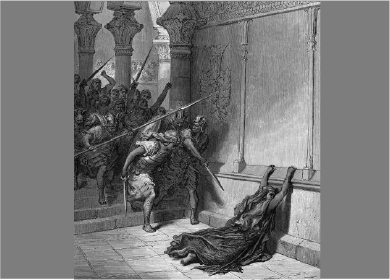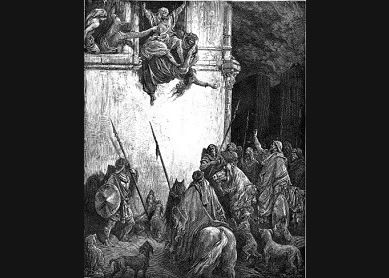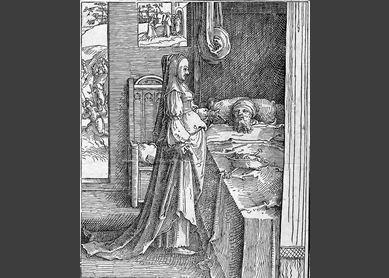Athaliah was a northern Israelite princess who married King Jehoram of Judah in the ninth century BCE. She was either the daughter of King Ahab of Israel (2Kgs 8:18) or the daughter of King Omri (2Kgs 8:26). Her marriage to Jehoram sealed an alliance between the kingdoms of Israel and Judah, and she became queen mother upon her son Ahaziah’s ascension to the throne of Judah (2Kgs 8:25-27). After Ahaziah’s untimely death she became Queen of Judah (2Kgs 9:27-28; 2Kgs 11:1-3). The Bible presents her as a foreigner who illegitimately seized the throne by murdering the Davidic royal family, and she was later assassinated in a coup organized by a priest.
How did Athaliah come to power?
The Bible claims that, upon hearing news of her son’s death, Athaliah murdered “all the royal seed” of Judah and became queen (2Kgs 11:1-3). However, her six-year reign (2Kgs 11:3) must have necessitated internal political support, so most scholars believe the accusations of her bloodshed are exaggerated. As King Ahaziah was only twenty-three when he was killed supporting the king of Israel in battle (2Kgs 8:26), his death likely threw the Davidic royal line into crisis as his heirs would have been too young to rule. Athaliah’s royal origins, familial connections to Israel, and experience as wife of King Jehoram and queen mother of King Ahaziah made her a strong candidate to steer Judah through the crisis. Whether she ruled in her own right as the sole queen or was a queen-regent ruling on behalf of Ahaziah’s heir(s) is uncertain. The Bible presents her as the sole ruler, though that may be intended to undermine her legitimacy and distance her successor from her legacy.
How did Athaliah’s rule end?
The Bible gives no information about events during Athaliah’s reign and instead focuses on the coup against her, organized by the priest Jehoiada. 2Kgs 11:3 states that the infant prince Joash was saved from Athaliah’s killing spree by his aunt, to be hidden and raised in the temple. After six years, Jehoiada liaised with the military captains and guards and they crowned Joash king in the temple (2Kgs 11:4-12). When Athaliah heard the noise, she came out, cried “treason, treason” but was executed on Jehoiada’s orders (2Kgs 11:13-16). Jehoiada and the people then made covenants (2Kgs 11:17), destroyed a temple of Baal (2Kgs 11:18-19), and Joash took his seat on the throne (2Kgs 11:20). The report of the coup is strongly political; the temple backdrop to the events and the rare example of coronation rituals (only seen in other contested successions 1Sam 11:15; 2Sam 2:4; 2Sam 5:1-5; 1Kgs 1:33-40) gives legitimacy to the actions of the conspirators. The coup is also gendered: Athaliah is the only woman mentioned and after her death, Joash takes his seat on the “throne of kings” (2Kgs 11:20).
Was Athaliah a Baal worshiper?
Although the biblical text reports a Baal temple was destroyed after the coup against Athaliah, she is not explicitly said to have been a Baal worshiper, nor to have built or encouraged the activities of the Baal temple. Only the Jewish historian Josephus made such a claim, around nine centuries after Athaliah’s death (Antiquities 9.154). Indeed, the name Athaliah means “Yahweh is great/large” or “Yahweh is exalted,” and she is never directly accused of any idolatrous worship; the closest biblical example of this is in 2Chr 24:7, which states that her children broke into the temple and used the vessels for the Baals. Even this does not accuse Athaliah directly. The detail is vague and evidently polemical—the royals likely did not have to “break into” the temple to gain entrance. Given the biblical authors’ tendency to highlight idolatrous worship wherever possible with foreign women (e.g., Jezebel, 1Kgs 16:31-32; 1Kgs 18:19), this raises the possibility that Athaliah was a Yahwist, which suggests the conspirators’ motivations were more political than religious. In any case, the destroyed Baal temple literarily brings the coup in 2Kgs 11 in line with Jehu’s coup against the northern Omride kings, which also culminated in the destruction of a Baal temple (2Kgs 10:1-28).
How is Athaliah Remembered?
The biblical authors present Athaliah’s reign as a brief interruption that threatened Judah and was ended by a priestly sanctioned coup seeking to restore order. By describing the coup in detail and ignoring events in her rule, they do their best to distract readers from dwelling on the implications of a woman holding such power. While presenting her as a failed, foreign usurper, the texts gloss over the fact that Joash was her grandson (2Kgs 11:2) and thus part-foreign and a usurper himself. The only two words attributed to Athaliah tell their own story of her betrayal: “treason, treason!”
Bibliography
- Macwilliam, Stuart. “Athaliah: A Case of Illicit Masculinity.” Pages 69–85 in Biblical Masculinities Foregrounded. Edited by Ovidiu Creanga and Peter Ben-Smit. HBM 42. Sheffield: Sheffield Phoenix, 2017.
- Branch, Robin Gallaher. “Athaliah, a Treacherous Queen: A Careful Analysis of Her Story in 2 Kings 11 and 2 Chronicles 22:10–23:21.” In die Skriflig 38 (2004): 537–59.
- Klein, Reuven Chaim. “Queen Athaliah, the Daughter of Ahab or Omri?” JBQ 42 (2014): 11–20.
- Kuloba, Wabayanga Robert. “Athaliah of Judah (2 Kings 11): A Political Anomaly or an Ideological Victim?” Pages 139–152 in Looking through a Glass Bible: Postdisciplinary Biblical Interpretations from the Glasgow School. Edited by A. K. M. Adam and Samuel Tongue. Leiden: Brill, 2014.
- Sergi, Omer. “Queenship in Judah Revisited: Athaliah and the Davidic Dynasty in Historical Perspective.” Pages 99–111 in Tabou et transgressions. Edited by J.-M. Durand, M. Guichard and T. Römer. OBO 274. Göttingen: Vandenhoeck & Ruprecht, 2015.





